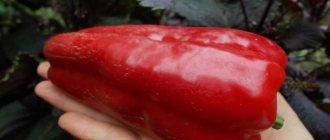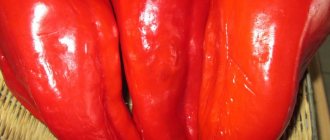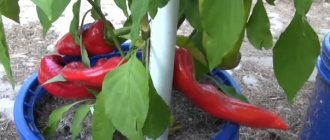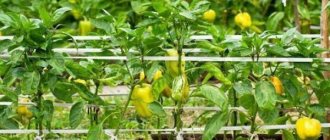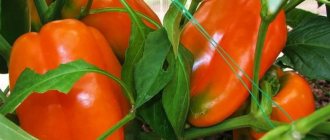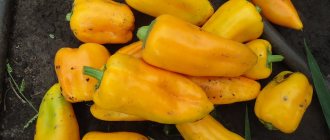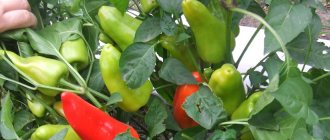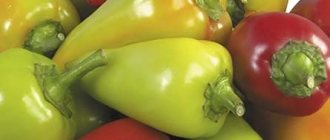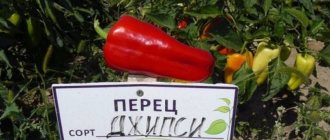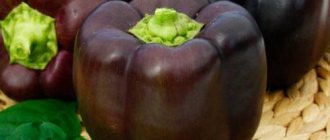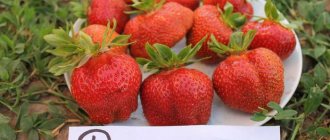Description and characteristics of the variety
Hercules is a good bell pepper for the middle zone with a temperate climate; cultivation is possible in cooler regions.
Sweet pepper Hercules grows in compact bushes, the height of which does not exceed 50-55 cm. The shape of the plants is semi-spreading, the stems have dark leaves with a wrinkled surface.
In terms of ripening time, the vegetable belongs to the early ripening varieties. It takes about 100 days from germination to ripening. On 1 plant, 8-12 fruits ripen at the same time.
Red Hercules pepper has a presentable appearance and excellent marketability. Among its characteristics:
- average weight 200 g;
- length 12-14 cm;
- diameter 10-12 cm;
- flattened cube shape;
- pericarp 7-9 mm;
- durable, non-cracking skin;
- the number of seed nests is within 3-4.
The value of the fruit is its fleshy pulp with a lot of useful components (ascorbic acid, B-vitamins, antioxidants and anthocyanins). They also have a lot of dry matter, which is convenient for winter preparations.
Hercules pepper has strong immunity to fusarium and a number of fungi, and shows significant productivity in open and covered beds. Vegetables are harvested in the phase of technical and full biological ripening. They are used for cutting, hot dishes, and stuffing.
Advantages and disadvantages of Hercules pepper
THE VARIETY HAS MANY ADVANTAGES:
- due to the large amount of dry matter, it is most suitable for all types of preparations;
- juicy and sweet fruits are not bitter and are considered universal in use;
- large-fruited;
- resistant to fusarium, tobacco mosaic virus; The fruits are characterized by good transportability, presentation, and high shelf life.
MINUSES:
- it is demanding of heat, and when the temperature drops below +21°C it grows, but bears fruit worse;
- demanding of soil nutrition.
Landing
After sowing, seeds germinate within 10-12 days. The quality of seedlings can be improved by disinfection (potassium permanganate, peroxide) and treatment with stimulants - Epin, Heteroauxin, Agate, Zircon. Farmers advise using natural activators - aloe juice, ash infusion. Treatment is carried out within 6-8 hours.
Then the seed material is laid out on a moistened cloth and covered with polyethylene. Do not allow the fabric to dry out. With the appearance of roots, the seeds are planted to a depth of 2 cm in a nutritious soil mixture.
Suitable containers:
- glasses and pots (at least 10 by 10 cm);
- boxes;
- cassette container.
Soil for filling is purchased or made from garden turf, rotted humus, compost, sand. All components are taken in equal proportions. Optimal acidity is neutral, at a pH level of 6-6.5.
After planting, the containers are covered with film, regularly moistened with a spray bottle, and the temperature is maintained at 25-26 degrees.
The care algorithm includes:
- creating a microclimate;
- hydration;
- picking in the phase of 2-3 leaves;
- feeding up to 2 times (infusion of litter, herbal tea, complex products containing nitrogen-phosphorus-potassium additives).
Composition for fertilizer per 2 liters – 1 g urea, 6 g superphosphate. For lighting with a total duration of up to 14-15 hours, fluorescent lamps or phytolamps are connected.
On the eve of transplantation, hardening of the seedlings begins. Within 10 days, the seedlings are placed on a balcony or loggia (time is increased from 15 minutes to 6-7 hours). Monitor the temperature, which should be at 14-15 degrees.
55-65 day old bushes are ready for planting in permanent beds.
Fruit characteristics
- The fruits are cube-shaped.
- They grow up to 12 cm in length and up to 11 cm in width.
- On average, one fruit weighs about 200 g.
- During the period of biological maturity they become rich red. At technical maturity they are dark green in color.
- The pulp is juicy and aromatic.
- The walls are thick, about 7 mm.
- There are 4 seed nests inside.
- Excellent taste and presentation.
- The fruits tolerate transportation well.
- They have good keeping quality.
Growing and care
Peppers need light and nutritious loose soil. Since the fall, the land has been treated with Bazudin or irrigated with Fitosporin to prevent infection. To heat the beds, you can cover them with fiber or black film. Fertilizers per 1 m2 include:
- 30 g superphosphate;
- 1 bucket of compost;
- 20 g potassium sulfate;
- 1 cup of ash powder.
The holes are dug at a distance of 30 cm, leaving a row spacing of 50 cm. The depth of the hole is 15-20 cm. Peppers are planted together with peat pots, without deepening the seedlings below the root collar. To make the bushes comfortable in greenhouses and under film, they monitor the regime - humidity at 60-65%, temperature 23-27 degrees.
The peppers are not watered for the first 6-8 days, then the frequency is set to 1-2 times a week. From the moment of ripening and at the height of the heat, the beds are moistened up to 2-3 times a week. Use settled water. Avoid contact with leaves and stems, soak the soil to a depth of 10-14 cm.
Before irrigation, check the soil moisture; it should dry out by 4-5 cm.
Mulching to retain moisture has a good effect. They use straw, hay, compost, and rotted sawdust. A layer of 7-8 cm is applied.
Pepper Hercules F1 needs 3-4 feedings per season. Fertilizers are applied 10 days after transplantation, at the budding stage and during ripening. They use organic matter (herbal teas, diluted mullein or dung), mineral compounds, complexes (Ideal, Agricola, Fertika, Dobrivo, Clean Sheet).
The formation is carried out in 2 stems, like the letter U.
Features of cultivation
The site for cultivating Hercules pepper must be chosen the one on which it was previously grown:
- legumes, excluding beans;
- pumpkin;
- cabbage;
- beet;
- carrot.
However, peppers should not grow near cucumbers.
Advice! Hercules grows best in light, fertile soil.
When and how to plant pepper seedlings
Pepper is sown for seedlings at the end of February or early March according to the gardener’s lunar calendar: lunar sowing calendar
Pepper seeds are sown in boxes of soil mixture, which can be purchased at a garden store. You can prepare the soil yourself. To do this, take soil from the garden, medium-sized sand and rotted compost in a ratio of 1:1:2. Mix all components well and add 2 tbsp. spoons of ash for each bucket of this mixture. To disinfect the soil, it is kept in the oven for 30 minutes at 160 degrees.
The seeds are soaked in a weak solution of potassium permanganate for 15-20 minutes, then washed and dried on a napkin, buried 1-1.5 cm into the soil. Next, the plantings are well watered with warm water from a spray bottle, covered with film and left in a room with a temperature of 23-25 degrees .
Important! The film must be removed daily for a few minutes for ventilation and watered if necessary.
After the first sprouts appear, the film is removed and the plantings are transferred to a well-lit place. Before transplanting to a permanent location, the seedlings are fed twice with special liquid fertilizers.
Picking
After the formation of 2 true leaves, picking is carried out. Pepper seedlings are difficult to tolerate this procedure, so it is recommended to immediately plant the seeds in separate cups, preferably peat cups.
2 weeks before transplanting to a permanent place, the seedlings begin to harden. During the day, she is taken out into the fresh air, first for 30 minutes, gradually increasing the time until full daylight hours.
Transplanting seedlings into the ground
Hercules seedlings are planted in open ground after it warms up above 15 degrees and the risk of night frosts has passed. This usually happens in late May - early June. Seedlings can be transferred to the greenhouse in early May. Planting pattern 40x60 cm.
For seedlings, dig holes and add 1 tbsp to each. spoon of mineral complex fertilizer (Nitrophoska). The seedlings are watered abundantly and removed from the cups along with a lump of earth so as not to injure the root system. If the seedlings were grown in peat cups, this makes the process easier, since they are placed in the hole along with the seedling.
The plantings are covered with soil and lightly compacted. In this case, the root collar of the seedling should be level with the soil.
As the fruits form and ripen, it is recommended to tie up the Hercules pepper bushes so that their stems do not break.
Read in another article: When and how to plant pepper seedlings: planting seeds, timing rules, preparing seeds and soil, care rules
You might be interested in: Secrets of growing bell peppers in a polycarbonate greenhouse and in open ground from seeds and seedlings
What type of pepper is this?
Mid-season crop: you will receive the first harvest 100 days after the appearance of the first shoots. Hercules is planted in seedlings: this way it shows the best yield.
Peculiarities
The bushes are compact, reaching 50 cm in length. The foliage is dark green, the leaves are medium-sized and oblong.
The recommended planting density for Hercules is 50x40.
Fruit characteristics and yield
The fruits are cube-shaped and slightly flattened. The peel is glossy bright red. Vegetable weight - from 150 to 300 g.
The wall thickness is 8 mm, so the crop tolerates transportation well over long distances.
The pulp is sweet, crispy, juicy, and there are few seeds. The yield is stable: about 3 kg is harvested from 1 bush.
Interesting ! 100 g of bell pepper contains 25 kcal. The vegetable strengthens the immune system and prevents vision problems. The fruits are rich in vitamins A, B, C, food acids, and antioxidants.
Diseases and pests
The Hercules variety is very popular due to its excellent resistance to common pests and dangerous diseases such as:
- tobacco mosaic;
- pepper spotted race virus;
- tolerant to cucumber mosaic, late blight;
- potato virus.
If, nevertheless, larvae of any parasites appear on the plants, the bush is treated with a disinfectant composition. Insecticides Keltan or Karbofos are effective against insects. Folk remedies include onion peel infusion, tobacco dust, and wood ash.
Hercules is most susceptible to viral diseases. Viruses damage plants and render them unusable. Diseased bushes must be removed and the area sprayed after them. This crop should no longer be planted in this place.
Fungal diseases can develop in dense areas. You can fight them with the help of the drugs Fundazol, Oxychom, Akara, Zaslon.
Hercules begins to bear its first fruits in mid-July. Huge peppers have an excellent appearance and decent taste, for which they are so loved not only by amateur gardeners, but also by industrialists. This variety sells well, as its fertility is unusually high. Peppers can be eaten not only when they are biologically ripe; they can also be eaten green and even canned.
Pepper bushes bear fruit intensively until mid-September. And if the weather is warm, then until October.
The fruits are stored quite well and for a long time in a cool, dark place.
Features and benefits of culture
Among other features of this variety, it is worth noting its rather large size. The average weight of these vegetables is 200-300 g. As for the length of the peppers, it ranges from 10 to 12 cm. The width of the vegetables is usually 11 cm.
Another attractive feature for gardeners is the high yield. If you care for vegetables correctly, then from 1 sq. m. you can remove from 2 to 3.5 kg of vegetables.
Among the advantages of this variety, it is worth noting its large fruit, versatility, good transportability, consistently high yield, excellent taste, and excellent keeping quality. In addition, the plant is highly resistant to many common diseases characteristic of these vegetable crops. The “Hercules” variety is not afraid of tobacco mosaic, which is common among peppers.
Attention! The plant can be cultivated even in regions with unfavorable climatic conditions. The variety is also resistant to the vagaries of weather.
From 1 sq.m. you can collect up to 4 kg of peppers
